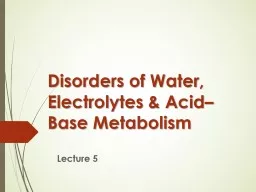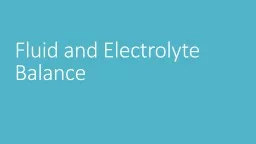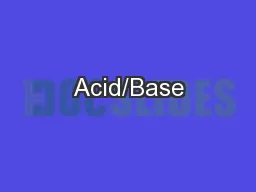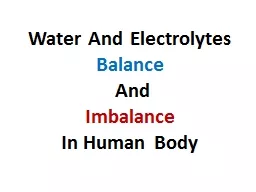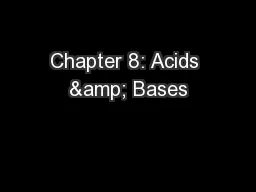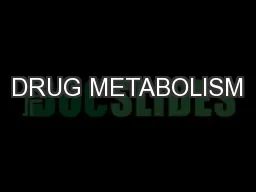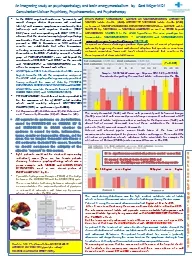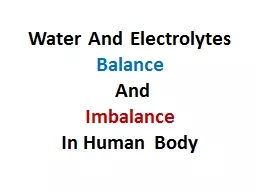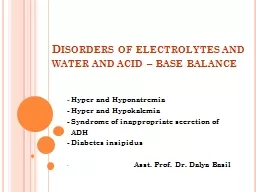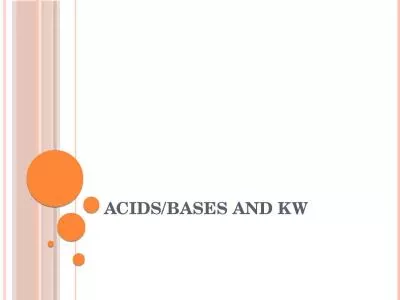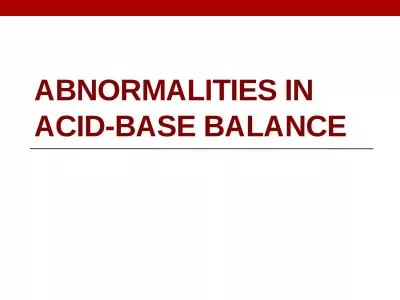PPT-Disorders of Water, Electrolytes & Acid–Base Metabolism
Author : daniella | Published Date : 2022-04-07
Lecture 5 Introduction A complex system of chemical buffers together with highly specialized mechanisms of the lungs and kidneys continuously work together to ensure
Presentation Embed Code
Download Presentation
Download Presentation The PPT/PDF document "Disorders of Water, Electrolytes & A..." is the property of its rightful owner. Permission is granted to download and print the materials on this website for personal, non-commercial use only, and to display it on your personal computer provided you do not modify the materials and that you retain all copyright notices contained in the materials. By downloading content from our website, you accept the terms of this agreement.
Disorders of Water, Electrolytes & Acid–Base Metabolism: Transcript
Lecture 5 Introduction A complex system of chemical buffers together with highly specialized mechanisms of the lungs and kidneys continuously work together to ensure a precise balance of water electrolytes and pH in both the intracellular and extracellular compartments of the human body . Definitions . Strong Acids. HCl. HBr. HI. HNO. 3. HClO. 4. H. 2. SO. 4. Acid: a species that supplies H. +. ions to water. Strong acid: an acid that completely ionizes in water forming an H. +. ion and an anion. What are Fluids and Electrolytes and what are their functions?. Body Fluid is the liquid portion of our cells and tissues. - intercellular fluid. - extracellular fluid. - tissue fluid ( interstitial fluid). Titration. Acid–Base Titration. The concentration of a weak acid or a weak base in water is difficult – if not impossible – to measure directly.. But we can calculate the concentration from the results of titration.. Prof. Tahir . Shafi. Why should we know about acid base disorders. What are acid base disorders. How to interpret acid base disorder. How to establish the cause. Why to worry about acid base disorders. Balance. And . Imbalance. In Human . Body. Dr. Anissa Atif Mirza. Body Water. Water. is the . chief constituent of human body.. Water is the . chief solvent of body.. Water . comprises 60-70% . of total body weight. Acids are all around us.. Foods like lemons, limes, and oranges contain acidic compounds.. When wine is oxidized, it becomes acetic acid.. Our muscles produce lactic acid.. Our stomach uses hydrochloric acid to break down food.. Department of Pharmaceutics. . . Drug metabolism or Biotransformation is the major mechanism for elimination of drug from the body.. . It is the process by which the drug is chemically modified . In the DSM5 disorders sign “personality and mood changes, abulia, depression, and emotional lability” as common symptoms in this category. emotionally labile (asthenic), and mild cognitive disorders (F06.3-06.7)”were not corresponding with And . Imbalance. In Human . Body. Dr. Anissa Atif Mirza. Body Water. Water. is the . chief constituent of human body.. Water is the . chief solvent of body.. Water . comprises 60-70% . of total body weight. - . Hyper and Hyponatremia. - Hyper and Hypokalemia. - Syndrome of inappropriate secretion of . ADH. - Diabetes . insipidus. . Asst. Prof. Dr. Dalya Basil . Disorder of Electrolytes. Taken from State University of West Georgia Chemistry Dept.. Acid and Base Strengths. Taken from State University of West Georgia Chemistry Dept.. Hydronium Ions. Hydronium Ions. H. 5. O. 2. +. Dissociation of Water. Many critical illnesses can disturb acid-base balance.. Acid-base disturbances may indicate an underlying disease or organ damage.. Accurate interpretation of acid-base disturbances requires the following:. Presentors. Kay . Gunckel. , DVM . Keri Riddick, DVM. What Are Electrolytes?. Sodium . na. Potassium k. Chloride cl. A horse needs electrolytes for muscle contraction (including the heart muscle). Electrolytes help preserve intestinal motility. Download PDF Acid Reflux Solution Kit™ eBook by Barton - a comprehensive step-by-step system designed to treat acid reflux and heartburn issues naturally.
Download Document
Here is the link to download the presentation.
"Disorders of Water, Electrolytes & Acid–Base Metabolism"The content belongs to its owner. You may download and print it for personal use, without modification, and keep all copyright notices. By downloading, you agree to these terms.
Related Documents

